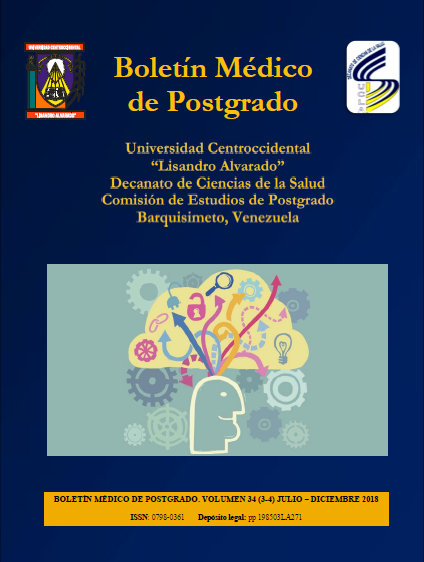Usefulness of the Pediatric Assessment Triangle in an emergency pediatric service
Keywords:
Pediatric Assessment Triangle, Emergency Service, pediatric patientAbstract
In the pediatric emergency room it is essential to recognize the clinical signs that indicate the threat of the patient’s condition on time. In order to establish the usefulness of the Pediatric Assessment Triangle (PET) in pediatric patients who attended the Emergency Service of the Servicio Desconcentrado Hospital Pediátrico Dr. Agustin Zubillaga during the period March-April 2018, a cross-sectional descriptive study was conducted with a total of 216 patients, with an average age of 2,98 ± 3,06 years, of which 36,11% were under one year old and 22,69% infants were one to two years old, with a slight predominance of males (53,70%). According to each component of the PET, 61,54% of patients had alterations in their appearance and general state, language (61,54%), state of consciousness (53,85%) and tone (50%). With respect to the work of breathing, subcostal retractions prevailed (86,21) as well as intercostal retractions (34,48%), expiratory moans (24,14%) and difficulty in speaking (17,24%). For the circulation part of the PET, pallor was register in mucous membranes (91,86%) and skin (54,05%). The physiopathological diagnoses were stability in 68,98% of cases, 9,26% had respiratory difficulty and 9,72% had compensated shock. The decision of admission was made in 13,89% of cases while 86,11% of cases were managed in an ambulatory manner. This study provides relevant information of the Pediatric Assessment Triangle as a useful tool to identify and classify the severity of a pediatric emergency in our hospital.
Downloads
References
2. Jayashree M, Singhi S. Initial assessment and triage in ER. Indian J Pediatr 2011; 78(9): 1100-8.
3. Dieckmann R, Brownstein D, Gausche M. The Pediatric Assessment Triangle, a novel approach for the rapid evaluation of children. Pediatr Emer Care 2010; 26(4): 312-315.
4. Thompson T, Stanford K, Dick R, Graham J. Triage assessment in pediatric emergency departments: a national survey. Pediatr Emerg Care 2010; 26(8): 544-8.
5. Alarcón J, Beltrán J. Triángulo de Evaluación Pediátrica. Rev Gastrohnup 2015; 17(3) supl. 1: s45-s49.
6. Haiyakulsil C, Pandee U. Validation of pediatric early war¬ning score in pediatric emergency department. Pediatr Int 2015; 57(4); 694-8.
7. Lugo S, Pavlicich V. Aplicación del Triángulo de Evaluación Pediátrica al sistema de clasificación de triaje en un servicio de urgencias. Arch Pediatr Urug 2014; 85(4):248-253.
8. Avilés K, López A, Luévanos A, Jiménez B, García M, Ceja H, et. al. Triaje: instrumentos de priorización de las urgencias pediátricas. Acta Pediatr Mex 2016; 37:4-16.
9. Fernández A, Ares M, García S, Martínez L, Mintegi S, Benito J. The validity of the pediatric assessment triangle as the first step in the triage process in a pediatric emergency department. Pediatric Emergency Care 2017; 33(4): 234-238.
10. Velasco R. Triángulo de Evaluación Pediátrica. Pediatr Integral 2014; (5): 320-323.
11. Horeczko T, Enriquez B, McGrath N, Gausche M, Lewis R. The Pediatric Assessment Triangle: accuracy of its application by nurses in the triage children. J Emerg Nurs 2013; 39(2): 182-9.
12. Cázares E, Acosta M. Valoración pediátrica inicial de urgencias. Acta Pediátrica Mex 2014; 35: 82-87.
Published
How to Cite
Issue
Section
Las opiniones expresadas por los autores no necesariamente reflejan la postura del editor de la publicación ni de la UCLA. Se autoriza la reproducción total o parcial de los textos aquí publicados, siempre y cuando se cite la fuente completa y la dirección electrónica de esta revista. Los autores(as) tienen el derecho de utilizar sus artículos para cualquier propósito siempre y cuando se realice sin fines de lucro. Los autores(as) pueden publicar en internet o cualquier otro medio la versión final aprobada de su trabajo, luego que esta ha sido publicada en esta revista.



